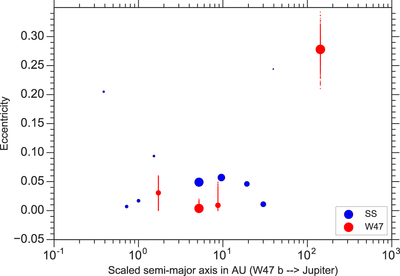Image Details

Caption: Figure 10.
The mean eccentricities of the WASP-47 and solar system planets vs. the orbital distances, scaled such that ab = aJ to facilitate comparison. The point size corresponds to ﹩{M}_{{\rm{p}}}^{1/3}﹩, to illustrate the mass range while keeping all the planets visible. The spread of each WASP-47 planet eccentricity is illustrated with a cloud of 1000 small red points drawn from the eccentricity posterior. The average eccentricity of the W47 planets is comparable to the average eccentricity of the solar system planets, if we include Pluto.
Copyright and Terms & Conditions
© 2017. The American Astronomical Society. All rights reserved.












